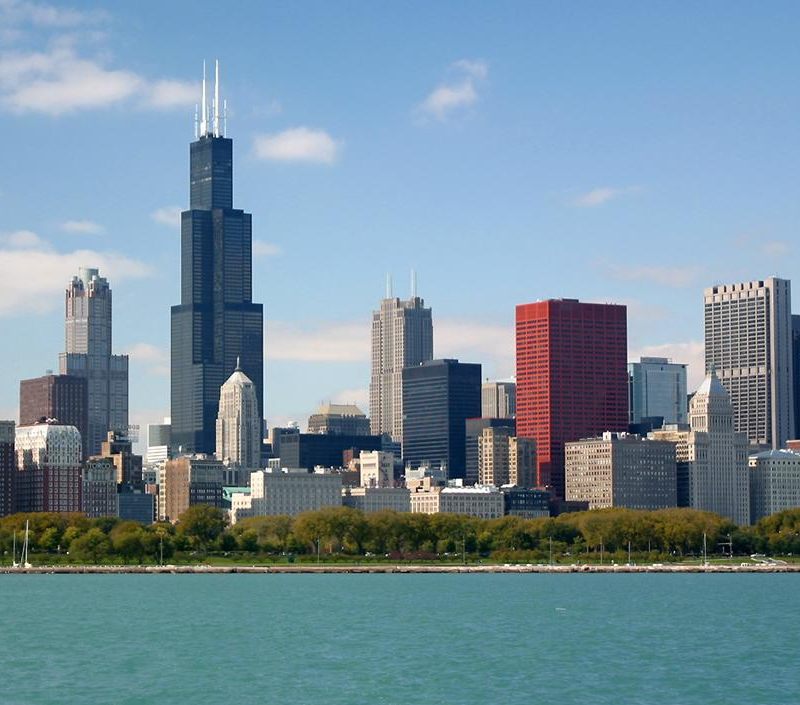 Chicago Illinois is one of the most exciting cities in North America, and anyone who experiences a Chicago vacation will surely agree. Chicago Illinois is a big city, with an infinite variety of attractions and Chicago hotels. Most people who return from a Chicago vacation make plans to return. It's impossible to see it all in a short period of time.
Chicago Illinois is one of the most exciting cities in North America, and anyone who experiences a Chicago vacation will surely agree. Chicago Illinois is a big city, with an infinite variety of attractions and Chicago hotels. Most people who return from a Chicago vacation make plans to return. It's impossible to see it all in a short period of time.Chicago Illinois Neighborhoods
Depending on what you would like to do on your Chicago vacation, you might want to focus on a specific neighborhood. For example, the Loop, or downtown Chicago is where you will find commercial, governmental, and cultural buildings that are contained within a corral of elevated train tracks.
The North Side is also known as the Magnificent Mile. This is where you find the trendy and elegant North Michigan Avenue, which is home to the city's best hotels, shops, and restaurants. The area stretching east of Michigan Avenue to the lake is often called "Streeterville." In the late 19th century, after his steamship ran aground, George Wellington "Cap" Streeter, an eccentric, bankrupt showman staked out 200 acres of self-created landfill in this area. He then declared himself "governor" of the "District of Lake Michigan."
River North is located to the west of the Magnificent Mile. This old warehouse district has experienced a rebirth as one of the city's most popular tourist districts. Today it is home to many of the city's hottest restaurants, nightspots, and art galleries.
 Chicago Trip
Chicago Trip
 Chicago Trip
Chicago Trip The buildings in the foreground of this photograph stand along Michigan Ave, which did indeed once run beside Lake Michigan. Despite many efforts by commercial interests to cut it up, Grant Park now stands along the lakeshore, protected by the protests of the people of Chicago under the leadership of public figures like department store magnate Montgomery Ward. Just as Central Park in New York acts as the lungs of that city, so does Grant Park provide a welcome green carpet next to the blue lake. Nevertheless, the skyline with its tall buildings is magnificent, quite appropriate for a place which is often considered the birthplace of the skyscraper, epitomized by the large black Sears Tower, tallest building in the United States.
The buildings in the foreground of this photograph stand along Michigan Ave, which did indeed once run beside Lake Michigan. Despite many efforts by commercial interests to cut it up, Grant Park now stands along the lakeshore, protected by the protests of the people of Chicago under the leadership of public figures like department store magnate Montgomery Ward. Just as Central Park in New York acts as the lungs of that city, so does Grant Park provide a welcome green carpet next to the blue lake. Nevertheless, the skyline with its tall buildings is magnificent, quite appropriate for a place which is often considered the birthplace of the skyscraper, epitomized by the large black Sears Tower, tallest building in the United States. 
 The biggest obstacle to completing this building was zoning. The parcel of land selected was only zoned for as 540-foot tall building and a 350-foot tall building. However, the developer managed to assuage the city, neighborhood groups, and local open space activists by developing a riverfront plaza with six stories of parking underneath. The developer is also going to put up $9 million to help create DuSable Park.
The biggest obstacle to completing this building was zoning. The parcel of land selected was only zoned for as 540-foot tall building and a 350-foot tall building. However, the developer managed to assuage the city, neighborhood groups, and local open space activists by developing a riverfront plaza with six stories of parking underneath. The developer is also going to put up $9 million to help create DuSable Park. 
 The Interior Plains are largely coincident with the vast Mississippi River Drainage System (other major components are the Missouri and Ohio Rivers), as seen in this map. These rivers have for tens of millions of years been eroding downward into the mostly horizontal sedimentary rocks of Paleozoic, Mesozoic, and Cenozoic ages. The modern Mississippi River system has developed during the Pleistocen Epoch of the Cenozoic Era.
The Interior Plains are largely coincident with the vast Mississippi River Drainage System (other major components are the Missouri and Ohio Rivers), as seen in this map. These rivers have for tens of millions of years been eroding downward into the mostly horizontal sedimentary rocks of Paleozoic, Mesozoic, and Cenozoic ages. The modern Mississippi River system has developed during the Pleistocen Epoch of the Cenozoic Era. This is the first Chicago project for Spanish architectural superstar Santiago Calatrava, though he has graced the shores of Lake Michigan before with the Milwaukee Art Museum's Quadracci Pavilion. Its position at the point where the Chicago River drains Lake Michigan puts it in the center of the city's skyline, and out in front of any of the thousands of photographs taken by tourists cruising the lake each day.
This is the first Chicago project for Spanish architectural superstar Santiago Calatrava, though he has graced the shores of Lake Michigan before with the Milwaukee Art Museum's Quadracci Pavilion. Its position at the point where the Chicago River drains Lake Michigan puts it in the center of the city's skyline, and out in front of any of the thousands of photographs taken by tourists cruising the lake each day.